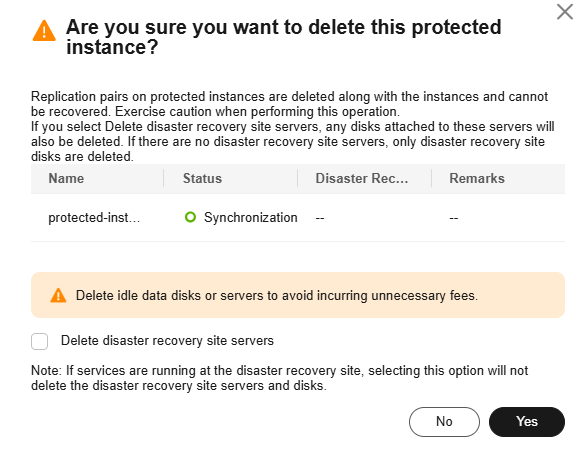Deleting a Protected Instance
Scenarios
You can delete protected instances no longer needed to cancel the replication relationship between production site servers and the disaster recovery site servers on Huawei Cloud.
Deleting protected instances does not delete production site servers and has no impact on production site services.
Precautions
- In the scenario that a reverse reprotection is performed for a protected instance, you are advised to delete the instance after the initial data synchronization is complete.
Prerequisites
No operations are being performed on the protected instance.
Procedure
- Log in to the management console.
- Click Service List and choose Storage > Business Recovery Service.
The Business Recovery Service page is displayed.
- Choose Asynchronous Replication. In the right pane, locate the replica pair housing the protected instance you want to delete and click the number in the Protected Instances column.
The Protection Groups tab page is displayed.
- In the navigation pane, choose the protection group housing the target protected instance.
The protection group details page is displayed.
- In the Protected Instances area, locate the target protected instance, and choose More > Delete in the Operation column.

To delete protected instances in a batch, select the target protected instances and click Delete above the protected instance list.

- In the displayed dialog box, select the following option as required:
 Delete disaster recovery site servers
Delete disaster recovery site servers- If you do not select this option, the replication relationship between the production site server and disaster recovery site server is canceled, but the disaster recovery site server and disks are retained.
- If you select this option, the replication relationship between the production site server and disaster recovery site server is canceled, and the disaster recovery site server and disks are deleted. If there are no disaster recovery site servers, EVS disks will be deleted.

If the protected instance is in the Failover completed or Reverse reprotecting state, meaning that services are running at the disaster recovery site, resources at the disaster recovery site will not be deleted regardless of whether you select this option or not.
- Click Yes. The protected instance status changes to Deleting.

- After the deletion is complete, the production site server is moved to the list of Unprotected servers.

Deleting a protected instance does not delete its disaster recovery drills. To delete its drills, go to the Disaster Recovery Drills tab page, as shown in Deleting a Disaster Recovery Drill.
Feedback
Was this page helpful?
Provide feedbackThank you very much for your feedback. We will continue working to improve the documentation.See the reply and handling status in My Cloud VOC.
For any further questions, feel free to contact us through the chatbot.
Chatbot





